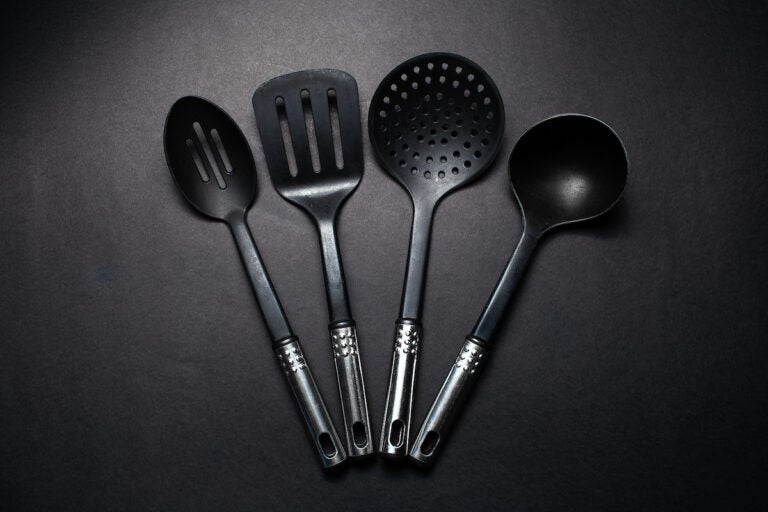How does electronic waste end up in black plastic kitchen utensils?
An alarming study on black plastic had a major math error. But it reveals bigger questions that have yet to be addressed.
Listen 8:54
Studio picture of black plastic kitchen utensils with chromed handles. (Bigstock/Lalandrew)
This story is from The Pulse, a weekly health and science podcast.
Find it on Apple Podcasts, Spotify, or wherever you get your podcasts.
Late last year, people turned against their black plastic kitchen utensils.
Toxic Free Future, an advocacy group, published scientific research showing that black plastic can contain alarming levels of flame retardants. But the study contained a major math error that overstated the potential impact of the flame retardant that people could be exposed to. The group has since corrected the error.
Regardless, the study revealed some bigger questions that still remain: How did the flame retardants get there in the first place? And, how common is it for black plastic food utensils to contain flame retardants?
The study found that black plastic that isn’t made from new material could come from recycled electronic waste, which contain flame retardants to prevent consumer electronics from catching fire. The researchers tested products like sushi trays, children’s toys, and notably, spatulas.
“People looked at the plastic utensils as if they were murderous items,” said Joe Schwarcz, a chemist and the director of the Office for Science and Society at McGill University in Canada.
Subscribe to The Pulse
He has taught a course on plastic for many years, and suddenly many people were frantically asking him about this study.
He, like others, noticed that the researchers had miscalculated the impact from the flame retardants people could be exposed to, to make it 10 times worse than it actually was, compared to standards set by the U.S. Environmental Protection Agency.
Toxic Free Future did not respond to requests for comment on this study. They corrected the math error in the article, but also said it does not change their conclusions.
Schwarcz said despite the error, the research is commendable: “that plastic should not be recycled into items that come in contact with food.”
He explained that could have happened because companies are now trying to address the plastic waste problem by not making as many products from new plastic. But at the same time, it is hard to find recycled black plastic. Recycling companies cannot sort black plastic from other plastic waste because they use infrared light to separate out different kinds of plastic; black plastic is not separated because infrared light does not detect black plastic because of its color.
One reliable source of black plastic is electronic waste, because those products go through a different recycling process to remove other materials like precious metals.
Ultimately, Schwarcz said people do not need to throw out their black plastic kitchen utensils, because: they are not as dangerous as people might have thought; and throwing them away will send them to a landfill, which is also bad. However, he said if people are buying new utensils, then they could consider ones made from steel or wood.
“We have to minimize our use of plastics,” he said. “If this whole story alerts people to being more careful about what they use and what they buy, then it will have served a purpose.”
Long before this particular study, environmental scientist Andrew Turner, an associate professor at the University of Plymouth in the U.K., has studied the impact of plastic, and especially black plastic. He said the findings did not surprise him, since he had found flame retardant chemicals in consumer products for years, including coat hangers, flasks, and straws. He has no plans for future research on black plastic at the moment, but said researchers have yet to find out how effective companies are at properly handling electronic waste, and what are the long-term effects of exposure to these chemicals.
Not long after the viral black plastic study last year, Australian epidemiologist Gideon Meyerowitz-Katz looked at the research closely and published a story in Slate with the headline: “I’m not throwing away my black plastic spatula.”
He said the other lesson from this story is how to read scientific papers critically. In this study, the researchers simulated the effect of cooking with black plastic spatulas by boiling them in oil for 15 minutes, and measuring the chemicals in the oil.
“In real cooking, you don’t just leave your cooking utensils inside your oil for 15 minutes, if for no other reason than: they start to burn and smoke and set fire to your kitchen.”
He said there is an inherent tension between news that is interesting and accurate representations of science.
“People by definition are only interested in new and interesting news. That’s what the news is,” he said. “But if you communicate science with all of the nuance, it’s often quite boring.”
Most studies add a small piece to a larger scientific question. Paradigm-changing scientific breakthroughs are rare, so it is unrealistic to expect a steady stream of them.
His advice, for people who read news about his own field of epidemiology, is to think carefully about whether a new finding applies to them or not.
“Epidemiological research is often interesting to people like me who look at entire populations of millions of people. But it’s often not as important to the individual who’s reading the newspaper article.”
WHYY is your source for fact-based, in-depth journalism and information. As a nonprofit organization, we rely on financial support from readers like you. Please give today.







